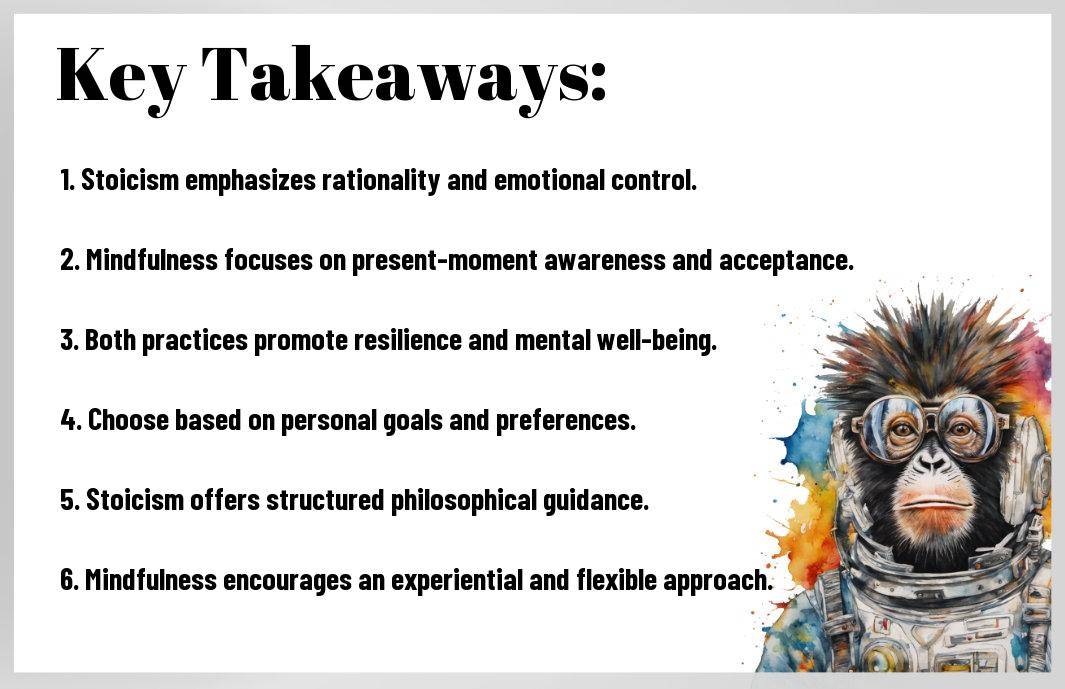Stoicism offers a powerful philosophy that encourages resilience and acceptance in the face of life’s challenges. On the other hand, mindfulness emphasizes being present and aware of your thoughts and feelings without judgment. As I explore these two popular approaches, I invite you to consider their unique benefits and how they can enhance your personal growth. Whether you find comfort in Stoic teachings or the calming practice of mindfulness, this post will help you determine which path resonates with you the most.
Key Takeaways:
- Philosophical Foundations: Stoicism is grounded in ancient philosophy focusing on virtue and rationality, while mindfulness is rooted in Eastern meditation practices emphasizing present-moment awareness.
- Emotional Regulation: Stoicism teaches emotional resilience through the acceptance of what one cannot control, whereas mindfulness encourages observation of thoughts and feelings without judgment.
- Practical Application: Both Stoicism and mindfulness offer practical tools for everyday life, but Stoicism often emphasizes principles for ethical living, while mindfulness focuses on enhancing mental well-being.
- Mental Clarity: Mindfulness aims to provide clarity through focused awareness, while Stoicism seeks clarity through rational thinking and reflecting on one’s values.
- Stress Management: Mindfulness is widely recognized for reducing stress by promoting relaxation, while Stoicism builds resilience by framing challenges as opportunities for growth.
- Personal Goals: Individuals seeking personal growth may find Stoicism’s focus on virtues meaningful, while those looking for emotional balance might prefer mindfulness practices.
- Flexibility: Both practices can be tailored to meet individual needs, and many find value in integrating elements from both Stoicism and mindfulness into their daily lives.

What is Stoicism?
Before venturing into the nuances of Stoicism, it’s crucial to understand its roots and core philosophy. Stoicism is an ancient Greek school of philosophy that teaches the development of self-control and fortitude as a means to overcome destructive emotions. At its heart, it emphasizes that while we can’t control external events, we can control our responses to them. This powerful realization can help us navigate life’s ups and downs more gracefully, ultimately leading to a more fulfilling existence.
Key Principles of Stoicism
Below, I want to explore some key principles that define Stoic thought. One foundational concept is the dichotomy of control, which distinguishes between what is within our control (our thoughts, feelings, and actions) and what isn’t (the opinions of others, the outcomes of our efforts). By focusing on what we can influence, we reduce unnecessary stress and frustration. Another vital aspect is the idea of virtue; a Stoic believes that living a good life is inherently tied to being a good person, valuing wisdom, courage, justice, and temperance above all else.
Benefits of Practicing Stoicism
Behind the practice of Stoicism lies a wealth of benefits that can enhance your daily life. One significant advantage is resilience in the face of challenges. By adopting a Stoic mindset, you can cultivate an inner strength that helps you remain calm and composed during difficult times. This approach has helped me respond to stressful situations with grace, instead of reacting impulsively. Furthermore, Stoicism allows you to foster a sense of gratitude, as it encourages you to appreciate what you have rather than focus on what you lack.
Due to its practical nature, practicing Stoicism can lead to improved mental clarity and emotional well-being. This philosophy offers tools for perspective-shifting, allowing you to reframe obstacles into opportunities for growth. Over time, you may find that your overall outlook on life transforms, embracing a mindset focused on long-term contentment and fulfillment. By incorporating Stoic practices into my daily routine, I’ve noticed a significant reduction in anxiety and an increase in my overall happiness.
Understanding Mindfulness
Assuming you are looking to explore mindfulness, it’s imperative to grasp what makes it unique and beneficial. Mindfulness is all about being present in the moment, fully engaging with your thoughts, feelings, and surroundings without judgment. By cultivating this awareness, you can develop a deeper understanding of your internal experiences and how they influence your behavior and decisions. It’s not just about meditation; it can be integrated into daily activities like eating, walking, or even just breathing. This approach allows me to appreciate the small details of life that I might otherwise overlook.
Core Concepts of Mindfulness
Mindfulness revolves around several core concepts that structure its practice. At its heart is the idea of awareness—bringing your attention to the present moment. It encourages you to observe your thoughts and feelings without getting swept away by them or labeling them as good or bad. Another important aspect is acceptance, which invites you to acknowledge the reality of your experiences without trying to change them. This can empower you to respond to situations with greater clarity and calmness.
Advantages of Mindfulness Practices
Any time I’ve practiced mindfulness, I’ve noticed a remarkable shift in how I cope with stress and emotional challenges. Mindfulness helps reduce anxiety and depression by fostering a sense of calm and clarity in everyday life. It has a way of guiding you to find balance, even in chaotic moments, improving your overall emotional regulation. Plus, it enhances focus, making it easier to engage in tasks with a fresh perspective.
Advantages of mindfulness practices extend beyond just stress relief; they can significantly enhance your overall wellbeing. For instance, I’ve found that regular mindfulness practice can lead to improved relationships. By being present, I’m better equipped to listen and connect with others, fostering deeper bonds. Additionally, you might be surprised at how it can boost creativity and enhance problem-solving skills, allowing you to approach challenges with a more open and innovative mindset.

Comparing Stoicism and Mindfulness
After exploring each philosophy on its own, I find it important to compare Stoicism and Mindfulness to see how they can complement or contrast with one another. Both practices offer valuable tools to navigate life’s challenges, but they do so through different approaches. In understanding these differences, I can better decide which might resonate more with my personal journey.
Similarities Between the Two
Similarities Between the Two
To begin with, both Stoicism and Mindfulness emphasize the importance of present-moment awareness. Whether through Stoic reflection or Mindful meditation, both practices encourage me to focus on the here and now, making it easier to unwind from the chaos of daily life. They both foster resilience, reminding me that not everything is within my control and that I can find peace regardless of external circumstances.
Additionally, another similarity is the way both philosophies promote self-awareness. Through Stoic exercises, I learn to recognize my thoughts and feelings, while Mindfulness teaches me to observe them without judgment. This self-awareness helps in understanding my responses to stress, allowing me to approach challenges with a clearer mind and a more grounded perspective.
Key Differences to Consider
Key Differences to Consider
Beside the similarities, there are notable differences between the two pathways. While Stoicism encourages me to cultivate virtues through rational thought and a focus on what is within my control, Mindfulness invites me to embrace my thoughts and emotions as they come without attaching to them. Stoicism often involves analytical reflection and the application of philosophical principles in my daily life, whereas Mindfulness emphasizes experiential awareness and non-judgmental acceptance.
Understanding these differences can help clarify your approach to daily life. If you lean more towards analytical thinking and prefer a framework to navigate emotional challenges, Stoicism might suit you well. However, if you find comfort in being in the moment and seek to cultivate a sense of openness and acceptance, Mindfulness may be the better choice. Ultimately, you might even find a harmonious blend of both practices works best for your individual needs.
Which is Right for You?
Despite the undeniable benefits of both Stoicism and Mindfulness, choosing the right one—or perhaps a blend of both—depends on your personal goals and needs. I find that self-reflection plays a pivotal role in this decision-making process. What are you seeking to achieve? Are you looking to cultivate emotional resilience and practical wisdom, or do you aim to increase your present-moment awareness and cultivate compassion? Each philosophy has its unique approach, so understanding your current desires can help illuminate the path that resonates most with you.
Self-Reflection and Personal Needs
Which aspects of your life feel overwhelming or unmanageable right now? Diving deep into your personal needs will assist in determining whether the structured frameworks of Stoicism can provide clarity or if the fluidity of Mindfulness is a better fit. For example, if you find yourself often losing control over your responses to external events, Stoicism could offer you the tools to change how you perceive challenges. On the other hand, if you struggle with anxious thoughts or a tendency to ruminate, Mindfulness practices could guide you toward a more peaceful state of mind.
Practical Tips for Integration
At some point, you might want to explore how to integrate elements of both Stoicism and Mindfulness into your daily life. I suggest starting with small, manageable practices. Try journaling about your thoughts and feelings each day as a way to engage with Stoicism’s reflective nature. You can also incorporate mindfulness techniques, such as focused breathing or body scans, to foster greater awareness of the present. Both practices can enrich your life without the pressure of having to adhere strictly to one philosophy.
- Establish a daily or weekly routine that allows you to dedicate time to both practices.
- Utilize resources like books, apps, or online communities to gain insights from both Stoicism and Mindfulness.
- Be open-minded and patient with yourself as you explore what resonates best.
Integration does not have to be an overwhelming task. I find it helpful to keep things simple and focus on what feels natural for me. For those looking to weave these philosophies into their lives, consider the following suggestions:
- Practice gratitude journaling to cultivate awareness of your thoughts and emotions.
- Engage in mindfulness exercises to help ground yourself in the present.
- Reflect on Stoic principles during moments of stress to alter your response.
Recognizing which framework feels most beneficial for your lifestyle can lead to greater personal development and well-being.

Real-Life Applications
Using Stoicism in Daily Life
Applications of Stoic principles in daily life can be quite transformative. I find it incredibly helpful to focus on what’s within my control and let go of the things that aren’t. For instance, when facing frustrations at work, I remind myself that my reactions and efforts are all I can truly influence. By doing so, I cultivate a calmer mindset and reduce feelings of stress. I also enjoy practicing gratitude in my daily routine; reflecting on what I’m thankful for not only boosts my mood but reinforces a Stoic appreciation for the present moment.
Mindfulness Techniques for Everyday Moments
Any moment can be an opportunity for mindfulness, whether you’re sipping your morning coffee or strolling down the street. One technique I like to use is grounding myself in the present by engaging my senses. For instance, when I eat, I pay full attention to the textures and flavors, which enhances my enjoyment and connects me to the experience. I also set aside a few minutes for deep breathing during my day, allowing myself to pause and reset whenever I need to, which helps me stay in tune with my emotions and surroundings.
Considering how busy our lives can be, integrating mindfulness techniques doesn’t have to be time-consuming or complicated. You can start by noticing the little things, such as the sound of birds chirping or the warmth of sunlight on your skin. By being present in these moments, I find that I become more attuned to my thoughts and feelings, which allows me to navigate life’s challenges with greater ease and clarity. Whether it’s through formal meditation or spontaneous moments of reflection, mindfulness can beautifully complement the Stoic approach to everyday living.
Resources for Further Exploration
Now that we’ve explored the nuances between Stoicism and Mindfulness, you might be eager to dive deeper. It’s always enriching to learn from others who have walked the path before us. That’s why I want to share some recommended readings that can provide a wealth of knowledge and insights into both practices. You can discover classic Stoic texts like Marcus Aurelius’s “Meditations,” which offers an intimate glimpse into a philosopher’s life and thoughts. Meanwhile, you can research into Mindfulness through works like Jon Kabat-Zinn’s “Wherever You Go, There You Are,” which really captures the essence of living in the present moment.
Recommended Readings
For those looking for more contemporary takes, I suggest exploring “The Daily Stoic” by Ryan Holiday, which presents bite-sized lessons that make Stoicism accessible for everyday life. On the Mindfulness side, Thich Nhat Hanh’s “The Miracle of Mindfulness” is an inspiring guide filled with practical exercises to cultivate mindfulness in your daily routine. These texts not only expand your understanding but also offer practical applications you can integrate into your life.
Online Courses and Communities
Against the backdrop of reading, there’s something special about joining a community or participating in a course where you can learn and practice together. You can find various online platforms that offer courses on both Stoicism and Mindfulness. Websites like Coursera and Udemy have educational resources that guide you through the principles and practices of these philosophies at your own pace. Furthermore, online forums and social media groups can provide a supportive environment where you can exchange thoughts, share experiences, and engage with others who are on a similar journey.
Consequently, participating in online courses or engaging with communities can enrich your experience immensely. You might find discussion boards, workshops, or even live meditation sessions that bring together individuals interested in exploring these practices. This interaction not only deepens your understanding but also creates meaningful connections with others, allowing you to share your insights and challenges along the way. So, whether you gravitate towards Stoicism, Mindfulness, or a blend of both, these resources can provide both knowledge and camaraderie on your journey.
To wrap up
Now that we’ve explored the nuances of Stoicism and Mindfulness, it’s clear that both philosophies offer unique insights for managing our thoughts and emotions. Personally, I find it rewarding to reflect on how these practices can enhance my daily life. Whether you gravitate more toward the rational approach of Stoicism or the present-moment focus of Mindfulness, integrating elements from both can lead to a more balanced perspective. It’s all about finding what resonates best with you, allowing you to navigate life’s challenges with resilience and calm.
If you’re curious about how to combine these two philosophies, I encourage you to check out Stoic Mindfulness in a Nutshell. I believe that experimenting with different techniques and approaches will help you discover what truly works for your needs. After all, the goal is to cultivate peace of mind and a fulfilling life, no matter the path you choose.
FAQ
Q: What is Stoicism?
A: Stoicism is an ancient Greek philosophy that emphasizes reason, virtue, and self-control. It teaches that individuals should focus on what they can control and accept what they cannot, promoting a sense of inner peace and resilience in the face of life’s challenges.
Q: What is Mindfulness?
A: Mindfulness is a mental practice that centers on awareness and being present in the moment. It involves observing thoughts and feelings without judgment, fostering a sense of calm and an improved understanding of one’s emotions and reactions.
Q: How do Stoicism and Mindfulness differ in their approach to emotions?
A: Stoicism encourages individuals to detach from their emotions and view them rationally, advocating for a focus on logical thought and virtuous action. In contrast, mindfulness embraces emotions, guiding individuals to fully experience and acknowledge their feelings without suppression or avoidance.
Q: Can Stoicism and Mindfulness be practiced together?
A: Yes, many find that combining Stoicism and mindfulness enriches their personal growth. By practicing mindfulness, one can cultivate awareness of their thoughts and emotions, which can enhance Stoic practices of focusing on rationality and control in challenging situations.
Q: Which practice is better for stress management?
A: The effectiveness of each practice in managing stress can vary from person to person. Mindfulness techniques often provide immediate relief from anxiety and stress through awareness and acceptance. Meanwhile, Stoicism offers long-term strategies for resilience by fostering a mindset that prioritizes acceptance and rationality.
Q: Are there specific techniques or exercises for each philosophy?
A: Yes, Stoicism often employs techniques such as negative visualization (contemplating potential losses) and distinguishing between what is within one’s control versus what is not. Mindfulness includes practices such as meditation, breathing exercises, and mindful observation, which help develop awareness and presence in daily life.
Q: How do I decide which philosophy is right for me?
A: Reflecting on your personal goals and experiences can guide you. If you seek emotional regulation and logical reasoning in dealing with life’s challenges, Stoicism may resonate more. If you are looking to enhance your awareness and acceptance of your present experiences, mindfulness may be more suitable. Experimenting with both practices can also provide clarity.



